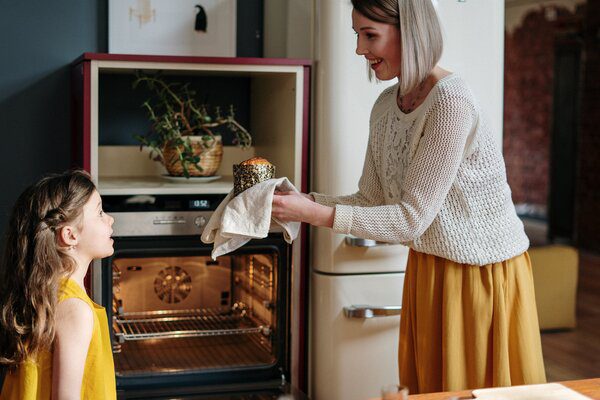Baking Cake in Convection Oven
Are you tired of your cakes turning out unevenly baked or lacking that perfect golden crust? Look no further – we have the ultimate guide to help you master the art of baking the perfect cake in a convection oven. Whether you’re a seasoned baker or a beginner, this comprehensive guide will equip you with all the knowledge and techniques you need to create moist, evenly baked cakes with a beautiful, professional finish.
From understanding the science behind convection baking to mastering the right temperature and timing, we’ll walk you through every step of the process. Plus, we’ll share expert tips and tricks to ensure your cakes come out flawlessly every time.
Understanding the difference between a convection oven and a conventional oven
When it comes to baking cakes, using a convection oven can make a world of difference. But what exactly is a convection oven, and how does it differ from a conventional oven? In a conventional oven, heat is generated from the bottom, and the hot air rises naturally, creating a temperature gradient inside the oven. This can result in uneven baking, with the top of the cake cooking faster than the bottom.
A convection oven, on the other hand, has a fan and an exhaust system that circulates the hot air evenly throughout the oven. This constant flow of hot air ensures that the heat is distributed evenly, resulting in cakes that are perfectly baked from top to bottom. The circulating air also helps to speed up the cooking process, meaning you can enjoy your cake sooner.
Using a convection oven for baking cakes offers several benefits. Not only does it ensure even baking, but it also helps to create a beautiful, golden crust on the outside of the cake. The constant flow of hot air also helps to remove moisture from the surface of the cake, resulting in a moist interior that is light and fluffy. With a convection oven, you can achieve bakery-quality results in your own kitchen.
Tips for preheating and setting the temperature in a convection oven
Before you start baking your cake, it’s important to preheat your convection oven properly. Preheating allows the oven to reach the desired temperature, ensuring that your cake bakes evenly from the start.
To preheat your convection oven, simply set the temperature to the desired level and allow it to heat up for about 10 to 15 minutes. Make sure to check the manufacturer’s instructions for your specific oven model, as preheating times may vary.
When it comes to setting the temperature for baking in a convection oven, it’s generally recommended to reduce the temperature by 25 degrees Fahrenheit (14 degrees Celsius) compared to what the recipe calls for. This adjustment accounts for the faster cooking time in a convection oven. For example, if a recipe calls for baking at 350 degrees Fahrenheit (175 degrees Celsius), you would set your convection oven to 325 degrees Fahrenheit (162 degrees Celsius).
It’s important to note that these temperature adjustments are just a guideline, and you may need to experiment with your specific oven to find the perfect temperature for your cakes. Keep an eye on your cakes as they bake, and adjust the temperature as needed to achieve the desired results. With a little practice, you’ll become a pro at setting the temperature for convection baking.
Choosing the right bakeware for baking in a convection oven
When baking cakes in a convection oven, choosing the right bakeware is crucial for achieving the best results. Opt for light-coloured, shiny pans that reflect heat and promote even baking. Dark-coloured pans tend to absorb more heat, which can lead to overbaking or uneven browning.
Another important factor to consider is the material of the bakeware. Aluminium pans are a popular choice for convection baking, as they conduct heat evenly and provide consistent results. Non-stick pans are also a good option, as they make it easier to remove the cake from the pan without sticking.
In addition to the material and colour, the size and shape of the pan can also affect the baking process. Choose a pan that is the appropriate size for your recipe, as using a pan that is too large or too small can result in uneven baking. For example, if your recipe calls for a 9-inch round cake pan, make sure to use a pan of that size.
Remember to also grease and flour your pans before adding the cake batter. This will help prevent the cake from sticking to the pan and make it easier to remove once it’s baked. By choosing the right bakeware, you’ll set yourself up for success in baking the perfect cake in your convection oven.
Adjusting baking times and temperatures for convection baking
One of the key differences between baking in a convection oven and a conventional oven is the cooking time. Due to the circulating hot air, convection ovens cook faster than their conventional counterparts. As a result, it’s important to adjust the baking time when using a convection oven for baking cakes.
A general rule of thumb is to reduce the baking time by about 25% when using a convection oven. For example, if a recipe calls for baking a cake for 60 minutes in a conventional oven, you would bake it for approximately 45 minutes in a convection oven. However, it’s important to note that these are just guidelines, and you may need to experiment with your specific oven to find the perfect baking time for your cakes.
To determine if your cake is done, you can use a toothpick or a cake tester to check for doneness. Insert the toothpick or tester into the centre of the cake, and if it comes out clean or with a few crumbs, the cake is ready. If the toothpick comes out with wet batter, continue baking for a few more minutes and check again.
By adjusting the baking time and keeping a close eye on your cakes as they bake, you’ll be able to achieve perfectly baked cakes with a moist, tender crumb. Practice makes perfect, so don’t be discouraged if it takes a few tries to get the timing just right. With time and experience, you’ll become a pro at adjusting baking times for convection baking.
Techniques for achieving even baking and browning in a convection oven
One of the benefits of baking cakes in a convection oven is the ability to achieve even baking and browning. The circulating hot air ensures that the heat is distributed evenly, resulting in cakes that are perfectly baked from top to bottom. However, there are a few techniques you can use to further enhance the evenness of your cakes in a convection oven.
First, make sure to rotate your cakes halfway through the baking process. This will help ensure that all sides of the cake are exposed to the same amount of heat, preventing any unevenness in baking. Simply open the oven door, carefully rotate the pans, and close the door as quickly as possible to avoid losing heat.
Another technique is to use baking strips or a cake wrap to insulate the sides of the pans. These strips or wraps can be soaked in water and then wrapped around the pans before baking. By insulating the sides of the pans, you can prevent them from heating up too quickly, resulting in more even baking.
Additionally, you can use the convection setting for the first half of the baking time and then switch to the conventional setting for the remaining time. This will help ensure that the top of the cake doesn’t brown too quickly while the interior finishes baking. Experiment with different settings and techniques to find the method that works best for you and your convection oven.
By implementing these techniques, you’ll be able to achieve beautifully even baked and evenly browned cakes in your convection oven. With a little practice and attention to detail, your cakes will be the talk of the town.
Avoiding common mistakes when baking in a convection oven
While baking in a convection oven can produce amazing results, there are a few common mistakes that can hinder your success. By being aware of these mistakes and taking steps to avoid them, you can ensure that your cakes turn out perfectly every time.
One common mistake is overcrowding the oven. It can be tempting to bake multiple cakes at once, especially when you’re in a hurry. However, overcrowding the oven can disrupt the airflow and result in uneven baking. Make sure to leave enough space between the pans for the hot air to circulate freely.
Another mistake is opening the oven door too frequently. While it’s natural to want to check on your cakes, opening the oven door can cause a loss of heat and disrupt the baking process. Try to resist the urge to peek inside until you think your cakes are close to being done. When you do open the oven door, do so quickly and close it again as soon as possible.
Using the wrong pan size can also lead to baking issues. As mentioned earlier, using a pan that is too large or too small can result in uneven baking. Make sure to follow the recipe’s instructions regarding pan size, or adjust the recipe accordingly if you only have a different size pan available.
Lastly, neglecting to preheat the oven properly can affect the baking process. Preheating allows the oven to reach the desired temperature, ensuring that your cakes bake evenly from the start. Make sure to allow enough time for the oven to preheat before adding your cakes.
By avoiding these common mistakes, you’ll set yourself up for success in baking perfect cakes in your convection oven. With a little attention to detail and some practice, you’ll become a pro at avoiding these pitfalls.
Troubleshooting common issues in convection oven baking
Even with all the knowledge and techniques at your disposal, baking in a convection oven can sometimes present challenges. However, with a little troubleshooting, you can overcome these issues and continue to achieve cake perfection.
One common issue is a cake that rises too quickly and then collapses in the centre. This can be caused by several factors, including overmixing the batter, using too much leavening agent, or baking at too high of a temperature. To prevent this, make sure to follow the recipe’s instructions carefully and avoid overmixing the batter. Additionally, double-check the temperature settings on your convection oven to ensure they are accurate.
Another issue is a cake that is dry or tough. This can occur if the cake is overbaked or if too much flour is used in the recipe. Pay close attention to the baking time and adjust as needed to ensure your cakes are moist and tender. Additionally, make sure to measure your flour accurately, as too much flour can result in a dense and dry cake.
Uneven baking and browning can also be a problem in convection oven baking. If you notice that one side of your cake is browning more quickly than the other, try rotating the pans halfway through the baking process, as mentioned earlier. This will help ensure even exposure to the circulating hot air and result in more consistent baking and browning.
By troubleshooting these common issues and making adjustments as needed, you’ll be well on your way to baking perfect cakes in your convection oven. Remember, practice makes perfect, so don’t be discouraged if it takes a few tries to get everything just right. With time and experience, you’ll become a master at troubleshooting and achieving cake perfection.

